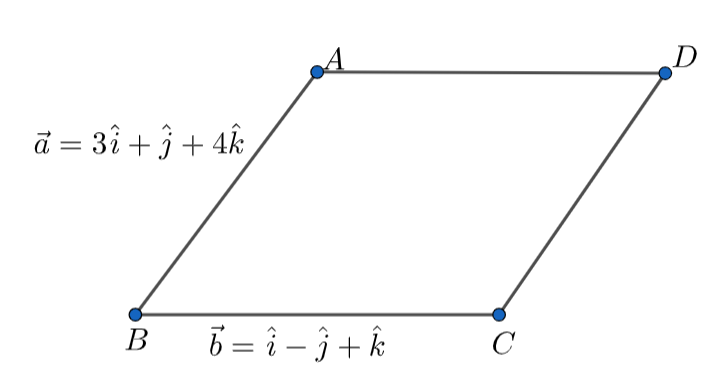
Find the area of a parallelogram whose adjacent sides are given by the vectors
\[\overrightarrow{a}=3\widehat{i}+\widehat{j}+4\widehat{k}\] and \[\overrightarrow{b}=\widehat{i}-\widehat{j}+\widehat{k}\] .
Answer
550.5k+ views
Hint: The adjacent side vectors of the parallelogram ABCD are \[\overrightarrow{a}=3\widehat{i}+\widehat{j}+4\widehat{k}\] and \[\overrightarrow{b}=\widehat{i}-\widehat{j}+\widehat{k}\] . We know the formula that if the vectors \[\overrightarrow{a}\] and \[\overrightarrow{b}\] are the adjacent sides of a parallelogram then the area of the parallelogram is the magnitude vector product of the adjacent sides of the parallelogram i.e., The area of the parallelogram = \[\left| \overrightarrow{a}\times \overrightarrow{b} \right|\] . Use this formula and calculate the area vector. Now, get the magnitude of the area vector using the formula that magnitude of a vector \[xi+yj+zk\] is \[\sqrt{{{x}^{2}}+{{y}^{2}}+{{z}^{2}}}\] .
Complete step by step answer:
According to the question, we are given the adjacent sides of a parallelogram in vector form and we are asked to find the area of the parallelogram.
The vector form of side AB of the parallelogram is \[\overrightarrow{a}=3\widehat{i}+\widehat{j}+4\widehat{k}\] ……………………………………..(1)
The vector form of side BC of the parallelogram is \[\overrightarrow{b}=\widehat{i}-\widehat{j}+\widehat{k}\] ……………………………………..(2)
Here, we have to find the area of the parallelogram.
We know the formula that if the vectors \[\overrightarrow{a}\] and \[\overrightarrow{b}\] are the adjacent sides of a parallelogram then the area of the parallelogram is the magnitude vector product of the adjacent sides of the parallelogram i.e., The area of the parallelogram = \[\left| \overrightarrow{a}\times \overrightarrow{b} \right|\] …………………………………..(3)

Now, from equation (1), equation (2), and equation (3), we get
The area of the parallelogram = \[\left[ \left( 3\widehat{i}+\widehat{j}+4\widehat{k} \right)\times \left( \widehat{i}-\widehat{j}+\widehat{k} \right) \right]\] ………………………………………..(4)
We know the property that \[\widehat{i}\times \widehat{i}=0\] , \[\widehat{j}\times \widehat{j}=0\] , \[\widehat{k}\times \widehat{k}=0\] , \[\widehat{i}\times \widehat{j}=\widehat{k}\] , \[\widehat{i}\times \widehat{k}=-\widehat{j}\] , \[\widehat{j}\times \widehat{i}=-\widehat{k}\] ,
\[\widehat{j}\times \widehat{k}=\widehat{i}\] , \[\widehat{k}\times \widehat{i}=\widehat{j}\] , and \[\widehat{k}\times \widehat{j}=\widehat{-i}\] ……………………………………..(5)
Now, from equation (4) and equation (5), we get
The area of the parallelogram ABCD = \[\left[ \left( 3\widehat{i}+\widehat{j}+4\widehat{k} \right)\times \left( \widehat{i}-\widehat{j}+\widehat{k} \right) \right]\] = \[\left( 5\widehat{i}+\widehat{j}-4\widehat{k} \right)\] ……………………………………..(6)
We know the formula for the magnitude of a vector \[xi+yj+zk\] , Magnitude = \[\sqrt{{{x}^{2}}+{{y}^{2}}+{{z}^{2}}}\] …………………………………………………(7)
Now, from equation (6) and equation (7), we get
The area of the parallelogram = \[\sqrt{{{5}^{2}}+{{1}^{2}}+{{\left( -4 \right)}^{2}}}=\sqrt{25+1+16}=\sqrt{42}\] .
Therefore, the area of the parallelogram is \[\sqrt{42}\] sq. units.
Note:
We can also solve this question using the matrix method formula that is, the area of the parallelogram whose adjacent side vectors are \[{{x}_{1}}\widehat{i}+{{y}_{1}}\widehat{j}+{{z}_{1}}\widehat{k}\] and \[{{x}_{2}}\widehat{i}+{{y}_{2}}\widehat{j}+{{z}_{2}}\widehat{k}\] is given by \[\left| \begin{align}
& \begin{matrix}
\widehat{i} & \,\,\,\widehat{j} & \widehat{\,k} \\
\end{matrix} \\
& \begin{matrix}
{{x}_{1}} & {{y}_{1}} & {{z}_{1}} \\
\end{matrix} \\
& \begin{matrix}
{{x}_{2}} & {{y}_{2}} & {{z}_{2}} \\
\end{matrix} \\
\end{align} \right|\] .
Complete step by step answer:
According to the question, we are given the adjacent sides of a parallelogram in vector form and we are asked to find the area of the parallelogram.
The vector form of side AB of the parallelogram is \[\overrightarrow{a}=3\widehat{i}+\widehat{j}+4\widehat{k}\] ……………………………………..(1)
The vector form of side BC of the parallelogram is \[\overrightarrow{b}=\widehat{i}-\widehat{j}+\widehat{k}\] ……………………………………..(2)
Here, we have to find the area of the parallelogram.
We know the formula that if the vectors \[\overrightarrow{a}\] and \[\overrightarrow{b}\] are the adjacent sides of a parallelogram then the area of the parallelogram is the magnitude vector product of the adjacent sides of the parallelogram i.e., The area of the parallelogram = \[\left| \overrightarrow{a}\times \overrightarrow{b} \right|\] …………………………………..(3)

Now, from equation (1), equation (2), and equation (3), we get
The area of the parallelogram = \[\left[ \left( 3\widehat{i}+\widehat{j}+4\widehat{k} \right)\times \left( \widehat{i}-\widehat{j}+\widehat{k} \right) \right]\] ………………………………………..(4)
We know the property that \[\widehat{i}\times \widehat{i}=0\] , \[\widehat{j}\times \widehat{j}=0\] , \[\widehat{k}\times \widehat{k}=0\] , \[\widehat{i}\times \widehat{j}=\widehat{k}\] , \[\widehat{i}\times \widehat{k}=-\widehat{j}\] , \[\widehat{j}\times \widehat{i}=-\widehat{k}\] ,
\[\widehat{j}\times \widehat{k}=\widehat{i}\] , \[\widehat{k}\times \widehat{i}=\widehat{j}\] , and \[\widehat{k}\times \widehat{j}=\widehat{-i}\] ……………………………………..(5)
Now, from equation (4) and equation (5), we get
The area of the parallelogram ABCD = \[\left[ \left( 3\widehat{i}+\widehat{j}+4\widehat{k} \right)\times \left( \widehat{i}-\widehat{j}+\widehat{k} \right) \right]\] = \[\left( 5\widehat{i}+\widehat{j}-4\widehat{k} \right)\] ……………………………………..(6)
We know the formula for the magnitude of a vector \[xi+yj+zk\] , Magnitude = \[\sqrt{{{x}^{2}}+{{y}^{2}}+{{z}^{2}}}\] …………………………………………………(7)
Now, from equation (6) and equation (7), we get
The area of the parallelogram = \[\sqrt{{{5}^{2}}+{{1}^{2}}+{{\left( -4 \right)}^{2}}}=\sqrt{25+1+16}=\sqrt{42}\] .
Therefore, the area of the parallelogram is \[\sqrt{42}\] sq. units.
Note:
We can also solve this question using the matrix method formula that is, the area of the parallelogram whose adjacent side vectors are \[{{x}_{1}}\widehat{i}+{{y}_{1}}\widehat{j}+{{z}_{1}}\widehat{k}\] and \[{{x}_{2}}\widehat{i}+{{y}_{2}}\widehat{j}+{{z}_{2}}\widehat{k}\] is given by \[\left| \begin{align}
& \begin{matrix}
\widehat{i} & \,\,\,\widehat{j} & \widehat{\,k} \\
\end{matrix} \\
& \begin{matrix}
{{x}_{1}} & {{y}_{1}} & {{z}_{1}} \\
\end{matrix} \\
& \begin{matrix}
{{x}_{2}} & {{y}_{2}} & {{z}_{2}} \\
\end{matrix} \\
\end{align} \right|\] .
Recently Updated Pages
Why is there a time difference of about 5 hours between class 10 social science CBSE

Master Class 12 Business Studies: Engaging Questions & Answers for Success

Master Class 12 Economics: Engaging Questions & Answers for Success

Master Class 12 English: Engaging Questions & Answers for Success

Master Class 12 Maths: Engaging Questions & Answers for Success

Master Class 12 Social Science: Engaging Questions & Answers for Success

Trending doubts
Who was the first woman to receive Bharat Ratna?

State and prove the Pythagoras theorem-class-10-maths-CBSE

State BPT theorem and prove it class 10 maths CBSE

What is the minimum age for fighting the election in class 10 social science CBSE

Describe the Salient Features of Indian Economy

The slogan Jai Hind was given by A Lal Bahadur Shastri class 10 social science CBSE




